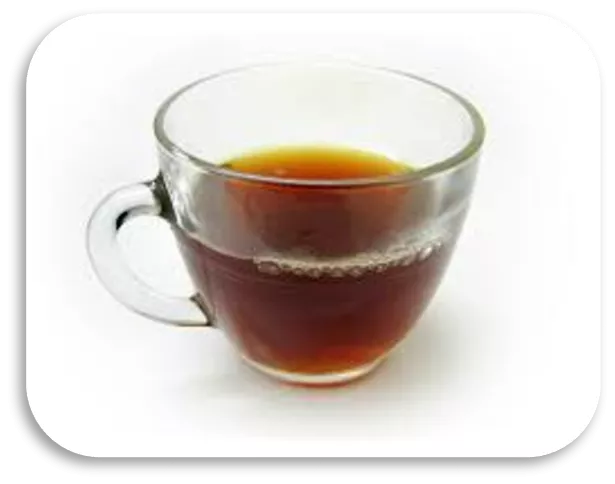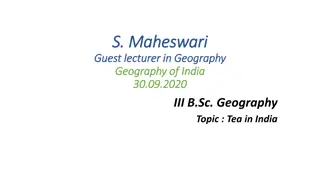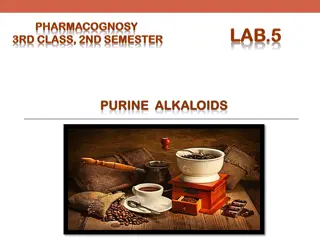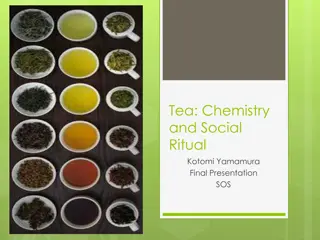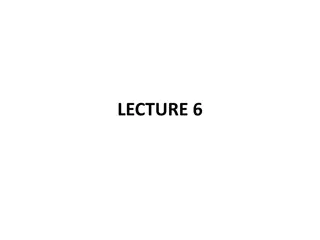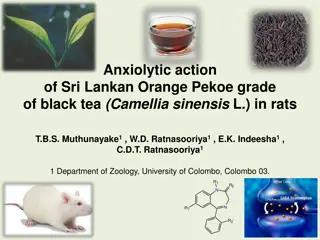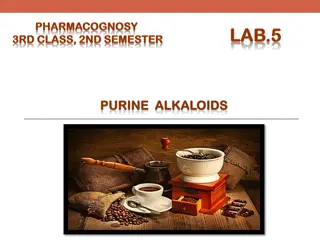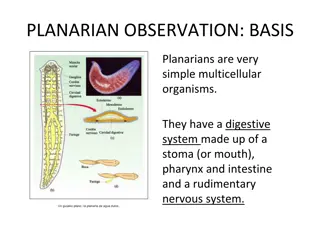Caffeine Content Analysis in Tea and Soft Drinks
Caffeine, a central nervous system stimulant found in various sources, can affect alertness and performance. Learn about its sources, effects, and mechanism of action, as well as the objective of determining caffeine content in tea and soft drinks using direct absorption.
Download Presentation

Please find below an Image/Link to download the presentation.
The content on the website is provided AS IS for your information and personal use only. It may not be sold, licensed, or shared on other websites without obtaining consent from the author.If you encounter any issues during the download, it is possible that the publisher has removed the file from their server.
You are allowed to download the files provided on this website for personal or commercial use, subject to the condition that they are used lawfully. All files are the property of their respective owners.
The content on the website is provided AS IS for your information and personal use only. It may not be sold, licensed, or shared on other websites without obtaining consent from the author.
E N D
Presentation Transcript
Determination of caffeine content in tea and soft drink
Caffeine Caffeine, the common name for 1,3,7-trimethylxanthine, It belongs to a group of methylxanthene
Sources of caffein Caffeine is a chemical that is found naturally in the leaves and seeds of various plants. Natural sources of caffeine include coffee beans, cocoa beans, kola nuts, tea leaves and fruits of more than 60 plants. Tea leaves contains 1.5% to 3.5% caffeine Roasted coffee beans contain 0.75% to 1.5% caffeine Cocoa bean contains 0.03% to 1.7% caffeine Caffeine can be added to energy drinks and some carbonated drinks and drug products Various carbonated beverages contain caffeine in the amount 30 to 60 mg per 355 ml.
The effect of caffeine Caffeine s main effect on your body is to make you feel more awake and alert for a while, but it can also cause problems. Many studies confirm caffeine's (if it consumed properly ) ability to enhance mood and, exercise performance, the speed at which information is processed, awareness, attention, and reaction time. Non proper consuming of caffeine can make you shaky, make it hard to fall asleep, your heart beat faster , raise your blood pressure , cause headaches, nervousness, In massive doses, caffeine is lethal. A fatal dose of caffeine is more than 10 grams (about 170 mg/kg body weight).
Caffeine is classified as a central nervous system stimulant : 1- An increase in heart rate. 2- Constriction of blood vessels. 3- Relaxed air passages to improve breathing. 4- ease of muscle contraction.
Mechanism of action Adenosine is a central nervous system neuromodulator that has specific receptors. When adenosine binds to its receptors, neural activity slows down, and you feel sleepy. Adenosine thus facilitates sleep and dilates the blood vessels. Caffeine acts as an adenosine-receptor antagonist. This means that it binds to these same receptors, but without reducing neural activity. Fewer receptors are thus available to the natural braking action of adenosine, and neural activity therefore speeds up. Caffeine also causes the pituitary gland to secrete hormones that in turn cause the adrenal glands to produce more adrenalin so it increases your attention level and gives your entire system an extra burst of energy.
Objective Determination of caffeine content in tea and soft drink using direct absorption of caffeine at 270 nm
Material 12 test tubes 2 measuring cylinder Pipette Quartz cuvette Separatory funnel Chloroform Caffein standard 100 g/ml Each group will either has tea or soft drink sample
Principle Even though caffeine is soluble in water, it is more soluble in chloroform. Therefore, caffeine can be extracted by chloroform from the aqueous mixture using Liquid-liquid extraction involves the distribution of a substance between two immiscible liquid phases. Caffeine absorb light at 270 nm directly Note that this method will give a general estimation of caffeine concentration, it will not give an accurate concentration of caffeine in the sample
Method 1-Sample preparation 1. 10 ml of (soft drink samples or hot water extract of tea samples) is taken in separating funnels, and 10 ml of chloroform was added to each sample. 2. The separating funnel should be shaken vigorously for 5 min while shaking, open the cover from time to time to release any pressure within the funnel. Be sure funnel is pointing away from you before opening. 3. The solutions then allowed to separate for 10 min at room temperature. 4. Only the lower chloroform layer will be collected for further analysis in a test tube or flask. 5. This chloroform layer will be diluted with pure chloroform (as shown in the table) appropriately to read absorbance. 6. Absorbance at 270 nm against pure chloroform as blank.
Chloroform layer (which must be collected)
- Method: 2-Preparation of caffeine standard curve Tubes Caffeine standard (100 g/ml) 0.1 0.2 0.3 0.4 0.5 0.6 0.7 0.8 ---- Sample Chloroform -- --- ---- ---- ---- ---- ---- ---- 2.9 2.8 2.7 2.6 2.5 2.4 2.3 2.2 S1 S2 S3 S4 S5 S6 S7 S8 (try different dilutions) sample
Result : Tubes Absorbance at 270 nm Caffeine Concentration g/ml S1 S2 S3 S4 S5 S6 S7 sample
- Calculations - Concentration ( g/ml)= conc. From curve x dilution factor
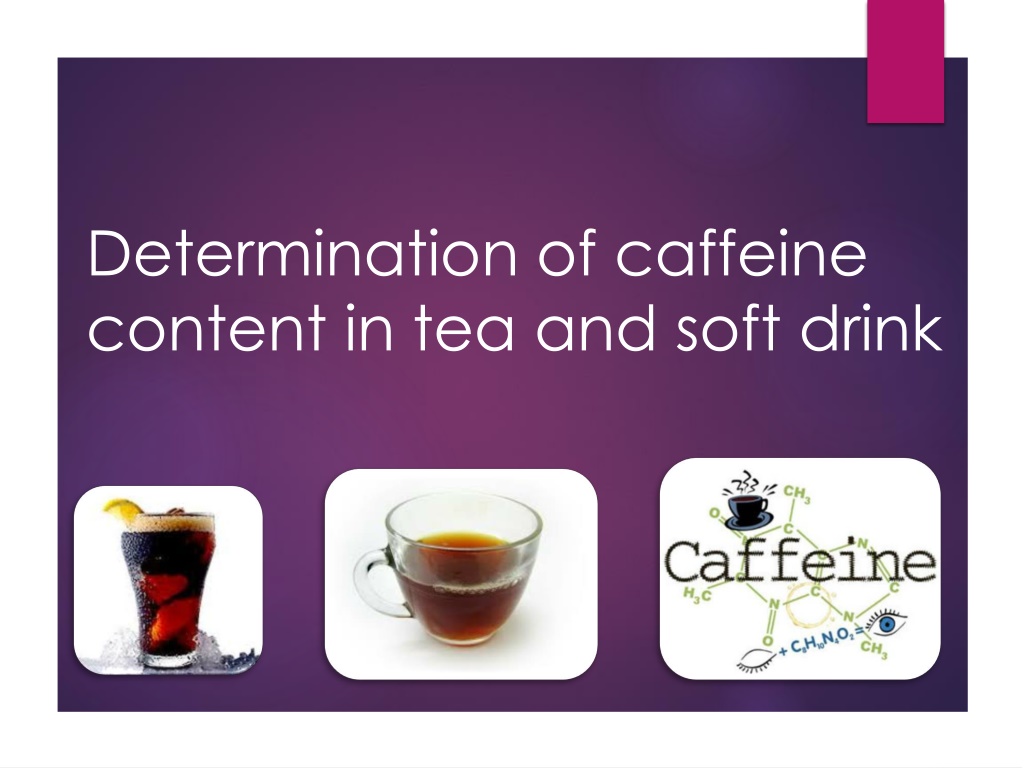
 undefined
undefined



